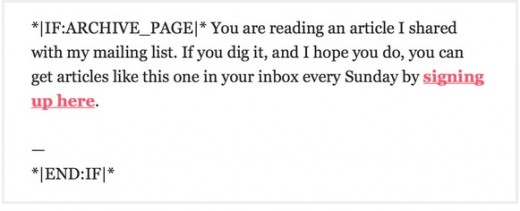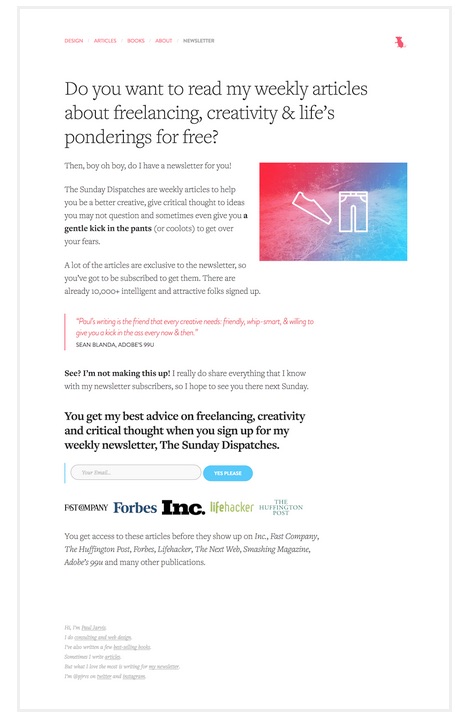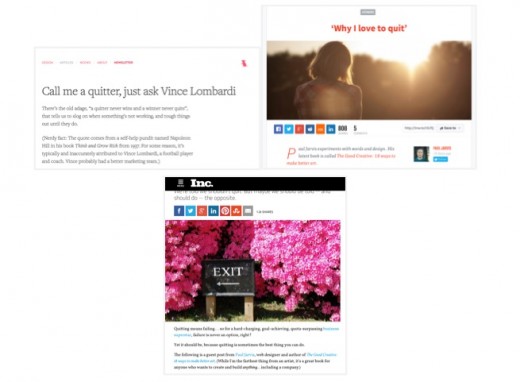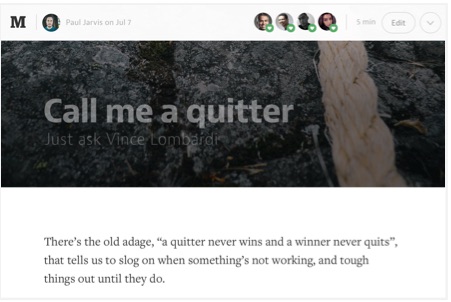
Paul Jarvis is a best-selling author and designer. He writes weekly for his popular newsletter and runs an online course on becoming a better freelancer.
I write for and in a lot of places. There’s my mailing list, my website, publications that require exclusive content, and even a few where my writing is regularly syndicated. Typically, although it seems like more, I write one article per week, and I write it with my mailing list in mind.
Because (last time I checked), I’m only one person with no assistant or help, I need for everything I do to be streamlined and quick.
I’ve worked out a fairly straightforward system that lets me focus more on writing and less on how it all works. No step, except for writing and editing, takes more than a few minutes.
And I’ll also note that is what works for me, in my industry, and for the specific topics I write about. Your mileage may vary, so use this as a guideline or something to think about, instead of just trying to blindly replicate it. The principles of it can work, with some critical thought, for anyone in any industry.
Here’s how my system works and the general timeline it follows, unless I’m being paid by a company or publication to write exclusively for them:
Wednesday – Brainstorm
1–2 hours
I look through my scratch pad (I’m constantly adding new ideas, words, articles, and sentences to a scratch pad for article ideas). What stands out? What do I wish I had already written? What have people asked me about lately?
I take one idea that I want to run with and start expanding upon it. Loosely, in point form, I write down every idea that comes to mind. I note any article associated with the idea (for points or counter points). I quickly try to write a rough first draft that is horribly written, probably not even in my writing style or voice, but gets all the points out that I want to make.
Here are four examples of ideas on my scratchpad currently:
- accountability (for freelancers—using a partner, a mastermind group, or making goals public so audience holds accountable)
- automating 50 percent of my onboarding (detail the new process vs old process, note amount of time for each, note reactions from clients about new process)
- sharing for introverts (how to get over fears and use SM + your voice in a way that works, 3–4 examples)
- before you create a product (steps needed to take before it’s made such as audience connecting, marketing, what’s the hook)
Thursday – Research & revisions
1–2 hours
Based on every point I made in rough draft, I look for supporting or counter evidence. On blogs, on news websites, on syndication sites for my industry, on Twitter, on Medium.com.
I collect any/all relevant data and pepper my piece with the details that fit into the story. I revise as necessary with the data to help the stories I’ve written, and then I revise again to fit it into my style and voice. This is typically a rewrite from scratch, with a new document on the left side of my screen and the rough draft with research on the right.
Most of my writing follows a simple formula that doesn’t make each article seem similar: story, proof, lesson. The formula makes for a solid piece every time, while the content always varies. Leading with an interesting personal experience connects my words to the reader. Then I back up the findings with proof: from research, other articles, or even stories from people I know. Finally, I like to sum up the general lesson—beyond myself, beyond the proof, to the bigger picture.
I paste the article into a Google Doc (I write in writer.pro because it keeps me from playing with formatting/style).
Friday – Proofreading/editing
1 hour
I read the article over once more with fresh eyes in the morning and then share the gDoc with my copyeditor. I get her to edit it for sentence structure and proper format but I also let her know if there are specific things I’d like her to watch out for. Sometimes it’s, “does this make me sound like an asshole?” or “Is this point clearly made?”
Once I get her revisions and comments back, I’ll make changes she suggested and we’ll both give it a final read.
Saturday – Scheduling
15–20 minutes
Now that the article is as perfect as it’s going to be, I format it for my mailing list and my website. I add any necessary images or illustrations, and I typically add a “PS” for my mailing list that lightly promotes or lets subscribers know what I’ve made or what I’m doing or what I’m promoting.
Here’s an example:
Here’s another example with a visual:
ASIDE: My list is article-focused, not promotion-focused, so I tend to only send out full-on sales emails once or twice a year. The other 51 weeks, I send them these articles for free.
Sunday – Newsletter blast
1 hour replying to newsletter replies
My newsletter goes out at 6 a.m. PST every Sunday with an article. The template I’ve created for these blasts includes a couple key things:
This message goes at the top and bottom of every email. Subscribers don’t see the message but if they share the article by forwarding it or sharing it on social media, others do see those messages.
In the footer, I have this:

Here’s my newsletter landing page:
MailChimp also lets you tweet or share on Facebook each blast as it’s sent out. Doing this shares the archive page (with the note from #1 about signing up). I also share the archive page a few more times each Sunday on social media, in case people missed the first update.
Monday – Publish & syndication
30 minutes
For the first 24 hours, readers only get access to the article via my mailing at the top and bottom. After that first 24 hours, I publish it on my own website.
People who subscribe to the RSS feed get notice, and I also promote it on social media using text from the article. So if I shared “Call me a Quitter, just ask Vince Lombardi” on Sunday, on Monday I’d say something like “A quitter never wins and a winner never quits is total BS.”
I also syndicate my writing on a few publications (The Huffington Post and The Next Web to name two), so I email my editor at each place a quick link to the gDoc to see if they want to run it on their sites. Most of the time, if it’s a good fit, they do. Promotion for the article on their sites happens through their social media channels, so I don’t worry about it other than checking to reply to comments, if there are any.
Here’s the same article in three different places (not including my newsletter). This helps it reach a larger audience (because readers of Inc. may not read my site or The Next Web, and vice versa).
The same article in three places:
If you’re just starting out, you don’t have to aim for massive publications. Try local media outlets, smaller sites that accept guest posts, or even putting your articles (if appropriate, of course) on related communities or message boards, LinkedIn blogs, Svbtle, or anywhere else you know people interested in the topics you write about already spend their time.
I also publish every article I write on Medium which is free to join and easy to use. I always end each article, in their largest font, with “This article first appeared on my Sunday Dispatches.” Sometimes the article gets picked up by the Medium editorial team and they tweet it out to 100,000s of people or share it with their newsletter. On average I get 1,000–2,000 views from Medium, and if the article goes into their social media or newsletter promotion, it goes up to 10,000–40,000+ views.
Tuesday – Outreach & aggregation
15 minutes
Because my writing is mostly specific to freelancers and creatives, I share relevant articles that I write with industry news aggregators. It differs for every industry, and I’m lucky because in the web design/freelancer sphere there are a lot of link aggregator sites.
- Sidebar.io – I post my articles there, and change any long titles to be much shorter.
- layervault.com – because I’m a web designer, and my articles apply to designers, I share here. Once posted on this site, articles go to their Twitter feed (which has thousands of followers).
- HackerNews – if the article I wrote fits their audience, I post it here as well. I don’t tend to get much traction on this site, but a few articles I’ve written have resulted in 1,000s of new readers, so it’s worth it on the off chance it pays off.
- Inbound.org – if my article is focused on marketing, I share it here.
- GrowthHackers – if my article fits HackerNews, it also fits here, so I post it.
- Reddit – if I can quickly find a subreddit that my article fits in, I’ll post it. Because my link karma isn’t very high, I don’t bother if I need to spend more than a few minutes figuring out where the post should go.
The above sites are listed in order of how much traffic each one sends my way. It’s important to note that I don’t just share my own articles on the above sites, because that would make me a jackass. Throughout the week I share many articles on each site that I think people should read. Sometimes they’re articles from my research or scratch pad, and sometimes they’re just articles I see on Twitter.
Posting articles to the above six places takes no more than five minutes total.
I then spend a bit of time with outreach by contacting anyone or any company I mentioned in the article (if any) to let them know about the article. This is either a 1–2 sentence email or a quick Twitter DM. I don’t accept payment or bribes for mentioning anyone in my articles. I talk about people and companies that I think are great, and help prove whatever point I’m trying to make.
I also share the article once or twice more on social media, using different wording to promote it.
Finally, I either personally thank or favourite each tweet about my article that others share. Sometimes it’s 100s an hour, so I can’t thank everyone, but I mentally thank people as I favourite their tweets, because they’re sharing something I wrote and I appreciate it.
I don’t use Facebook or LinkedIn or Pinterest. I don’t share articles on Instagram. I primarily use Twitter and occasionally Google+ because I don’t want to spread myself too thin.
That’s it!
That’s my seven-day cycle for creating content every week that gets read and shared at least 30,000 times total and grows my mailing list by hundreds of subscribers per week, on average.
In all, approximately six hours of work for each article. But the payoff is hundreds of books sold and hundreds of new subscribers per week.
I could potentially write an article per day and just pump them out, but I’d rather focus on quality than quantity. By putting days instead of hours into each piece, I can really get across the point I’m trying to make with a mix of personal stories, research, and interesting examples.
Yes, it’s a lot of work, but I’ve been doing this for over a year, so it’s baked into my routine. I also see the payoff when I release a new book or product with greater and greater sales from having a larger audience.
Plus —most importantly— the reason I do all of the above is because I like to share things I know and things that I’ve learned. If that didn’t matter to me, none of the above would be worth it.
Read Next: How to onboarding your clients help manage expectations
Get the TNW newsletter
Get the most important tech news in your inbox each week.






